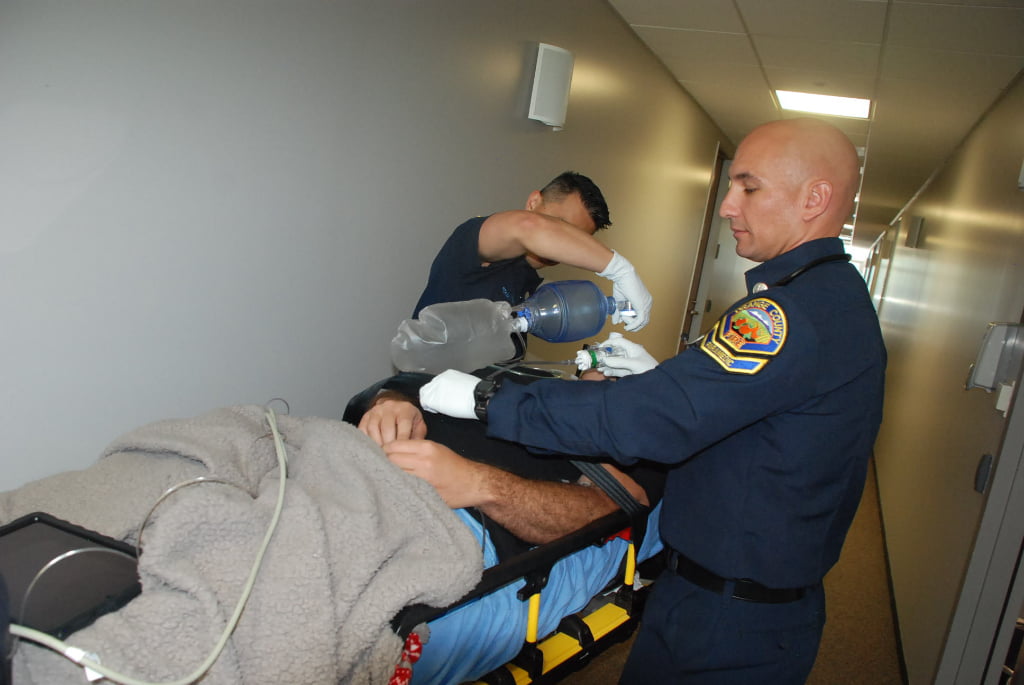
Photo/A.J. Heightman
The colored valve attached at the end of many bag-valve-mask (BVM) devices might not look like much, but is remarkably critical in preventing ventilation-induced injury to lung tissue. An underrated gadget, often forgotten about in the EMS classroom—the PEEP valve, is a tried and true solution to the historical design error of the prototypical BVM. To create a standardized approach for understanding the fundamentals of positive end expiratory pressure (PEEP), we have developed the acronym “SOKET” for EMS clinicians at both the BLS and ALS level to remember the core principles of implementing PEEP in their practice.
Related: Why PEEP?
What is PEEP?
Positive end expiratory pressure (PEEP) is a method of providing positive pressure, which is greater than atmospheric pressure, in the airways at the end of passive expiration.1 Stiffening of the lungs is one important complication of ventilation-induced lung injury.2 Increased lung stiffness leads to collapse of alveoli and impaired oxygenation.2, 3 PEEP helps in opening collapsed alveolar airways at end expiration, leading to improved oxygenation.1, 3
S: Sick Lungs are Stiff Lungs
Emergency pulmonary pathology typically presents in decreased compliance, meaning the sicker the lungs, the less elastic they are. Increased lung stiffness (and decrease in elasticity) increases the likelihood of alveolar collapse at end exhalation. Alveolar collapse, also known as atelectasis, contributes to hypoxemia and results in difficulty with manual ventilation, often referred to as “difficult to bag”.
O: Oxygenation is Both Inhale and Exhale
As EMS clinicians, we are very familiar with the 1 breath every 5-6 seconds rule and the E-C method— but bagging patients should involve thinking about expiration just as much as inspiration. The most convenient prehospital method for monitoring exhalation efficiency is an end tidal waveform (capnography) or capnometry. EtCO2 values of > 45 mmHg may impair proper oxygenation and lead to acidosis. Respiratory acidosis can be secondary to CO2 trapping in the alveoli. The early release and prevention of trapped CO2 is critical in preventing metabolic acidosis.
K: Keep the PEEP!
PEEP keeps a small amount of pressure in the lungs at end expiration rather than letting it return to atmospheric pressure. This pressure inside the lungs pushes the alveoli outwards and prevents them from collapsing. PEEP increases the volume of gas inside the lung at the end of expiration. Keeping the PEEP is essential to recruitment of alveoli, which equates to improved oxygenation when paired with increased FiO2.
E: EtCO2 Should Decrease
EtCO2 is a useful tool for EMS clinicians to assess perfusion and ventilation, as well as to surmise whether adequate oxygenation is occurring. Normal EtCO2 values range between 35 to 45 mmHG. High EtCO2 values suggest inadequate ventilation and oxygenation. EtCO2 values tend to spike with the initiation of assisted ventilation and delcine once excessive CO2 is washed out of the lungs. In this assisted ventilation process, PEEP decreases pulmonary CO2 elimination with each breath as oxygenation increases and alveolar PCO2 decreases.4 PEEP also increases the functional residual capacity (FRC), and the associated decrease in expiratory volume leads to a decrease in CO2 accumulation;4 thus, decreasing EtCO2.
T: Titrate to 10+
When attempting to increase oxygenation, PEEP is typically started at low levels of 5 CWP and titrated to higher levels of 10+ CWP as alveoli are recruited. At 16 CWP, PEEP helps significantly reduce overaerated lung regions, and the percentage of nonaerated lung regions does not increase.5 This increased PEEP level helps increase the partial pressure of oxygen in arterial blood/fraction of inspired oxygen (P/F) as well as static respiratory system compliance (Crs). At PEEP levels less than 16 CWP, nonaerated lung regions significantly increase, and P/F and Crs deteriorate.5 Although titrating to 10+ CWP is typically beneficial, it is important to consider the contraindications of PEEP in cases of hypotension, pneumothorax, cardiac arrest, and worsening barotrauma. Titrating PEEP to 10+ CWP should aim to balance lung overinflation and collapse with increased oxygenation as best suited for the clinical presentation — a process that can be well-monitored with capnography.
The tendency to discount PEEP in initial EMS education programs calls for the institution of a convenient mnemonic for quickly remembering some of the core principles of improving oxygenation. You are welcomed and encouraged to cite SOKET in any and all of your EMS curriculum and teaching materials to help your students! This mnemonic device was crafted through collaborative effort at the Pro Bono EMS Pandemic Response Research Lab.
References
- Acosta P, Santisbon E, Varon J. “The use of positive end-expiratory pressure in mechanical ventilation”. Crit Care Clin. 2007 Apr;23(2):251-61, x. doi: 10.1016/j.ccc.2006.12.012. PMID: 17368169.
- Bates JHT, Smith BJ. Ventilator-induced lung injury and lung mechanics. Ann Transl Med. 2018 Oct;6(19):378. doi: 10.21037/atm.2018.06.29. PMID: 30460252; PMCID: PMC6212358.
- Rossi A, Santos C, Roca J, Torres A, Félez MA, Rodriguez-Roisin R. Effects of PEEP on VA/Q mismatching in ventilated patients with chronic airflow obstruction. Am J Respir Crit Care Med. 1994 May;149(5):1077-1084.
- Breen P, Mazumdar B. How does positive end-expiratory pressure decrease CO2 elimination from the lung?. Respiration physiology. 1996;103(3):233-242.
- Yang Y, Huang Y, Tang R, et al. Optimization of positive end-expiratory pressure by volumetric capnography variables in lavage-induced acute lung injury. Respiration. 2014;87(1):75-83.
Christian Ventura, NREMT, EMS-I, FHAMES, is an EMS clinician, lecturer, and scientific researcher with publications in cognitive neuroscience and EMS science. He is the author of The Emergency Medical Responder by Springer Nature, and Host of Evidence-Based EMS at JEMS.
Barnita Haldar, MD, PhD, is a physician scientist specializing in acute respiratory disease and prehospital medicine. She is the co-principal investigator of the EMS Pandemic Response Research Lab.
Amber Chan, NREMT, is an EMS provider and published researcher with an academic background in behavioral neuroscience and business administration. She is a research member of the EMS Pandemic Response Research Lab.




